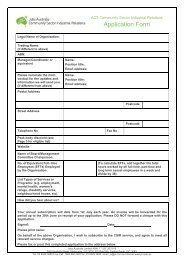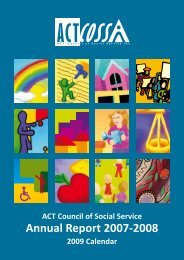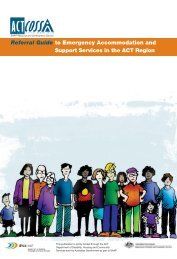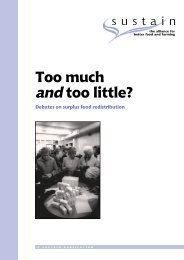actcoss text final.indd - ACT Council of Social Service
actcoss text final.indd - ACT Council of Social Service
actcoss text final.indd - ACT Council of Social Service
You also want an ePaper? Increase the reach of your titles
YUMPU automatically turns print PDFs into web optimized ePapers that Google loves.
to effective collaboration include: poor interpersonal<br />
relationships between management<br />
staff, a sense that there is organisational ‘turf’<br />
to be defended, efforts to expand a ‘domain’,<br />
‘pr<strong>of</strong>essional defensiveness’, ‘status differences’,<br />
major resource disparities and policy disagreement. 39<br />
Each relationship between community mental<br />
health services and different parts <strong>of</strong> the sector<br />
varies, raising particular challenges. Consultation<br />
responses on the issue <strong>of</strong> inter-sectoral collaboration<br />
varied depending on the relevant service area,<br />
organisational structure and philosophy and the<br />
personal relationships existing between management<br />
and frontline staff.<br />
Finally, research on partnerships and collaboration<br />
generally stresses that not all partnerships should<br />
move to collaboration. 40 Effective partnerships<br />
require high levels <strong>of</strong> trust, a continuing commitment<br />
to collaboration, the human and financial resources<br />
to support collaboration at all organisational levels<br />
and a well-integrated internal organisational<br />
structure that is conducive to collaboration.<br />
Reflecting these criteria, the <strong>ACT</strong> Community<br />
Facilities Needs Assessment found that increased<br />
resource sharing was likely to work best where<br />
organisations have similar structures or functions and<br />
are co-located.<br />
There is considerable debate about the possible role<br />
that government can and should play in facilitating<br />
community sector collaboration. Some organisations<br />
expressed the view that a requirement to collaborate<br />
should be included in government funding contracts.<br />
The alternative view is that government should<br />
facilitate and support collaboration, without<br />
forcing it. Emerging research on partnerships and<br />
collaboration indicates that collaboration works best<br />
when voluntary and where there is a pre-existing<br />
relationship between organisations. This is supported<br />
by the <strong>ACT</strong> Community Facilities Needs Assessment<br />
report conclusion that collaborations work best<br />
where they are voluntary or self-initiated, rather<br />
than coerced. 41 This report highlighted the need<br />
for community organisations to be resourced to<br />
collaborate. 42<br />
The concept <strong>of</strong> collaboration is central to this paper.<br />
Having established the meaning, forms, benefits<br />
and challenges <strong>of</strong> collaboration, this paper seeks<br />
to determine the extent to which collaborative<br />
approaches to mental health service delivery have<br />
developed in the <strong>ACT</strong>. In doing so, the paper analyses<br />
cooperative initiatives and projects currently being<br />
undertaken in the <strong>ACT</strong> though an examination <strong>of</strong><br />
relationships between different parts <strong>of</strong> the service<br />
system. It concludes that, although existing initiatives<br />
represent a promising starting point, it remains true<br />
to say that cooperation is proceeding in an ad hoc<br />
rather than systemic fashion. This paper therefore<br />
identifies priority areas in which collaboration can be<br />
improved between parts <strong>of</strong> the system. In addition,<br />
it identifies ways in which government can facilitate<br />
collaborative activity though appropriate support.<br />
In doing so, it is hoped that this paper might assist<br />
in the development <strong>of</strong> a more integrated service<br />
system with improved outcomes for mental health<br />
consumers and the community.<br />
___________________________________________________________________________________________________________________________<br />
39 Dr Rae Walker, Collaboration and Alliances: A Review for Vichealth, September 2000, published by Victorian Health Promotion Foundation at 11.<br />
40 See, for example, VicHealth, The Partnerships Analysis Tool: For Partners in Health Promotion accessed at http://www.vichealth.vic.gov.au/assets/contentFiles/<br />
VHP%20part.%20tool_low%20res.pdf. Also see Dr Rae Walker, Collaboration and Alliances: A Review for Vichealth, September 2000.<br />
41 Ibid.<br />
42 Stage 1 and 2 <strong>of</strong> the Community Facilities Needs Assessment<br />
[PALM (2003)] <strong>ACT</strong> Community Facilities Needs Assessment (Central Canberra, Belconnen and<br />
Gungahlin) at 24 and <strong>ACT</strong>PLA (2004) Community Facilities Needs Assessment: Report for Stage 2 at 35.<br />
15 Towards an integrated mental health service system in the <strong>ACT</strong>•June 2007 NO WRONG DOORS













